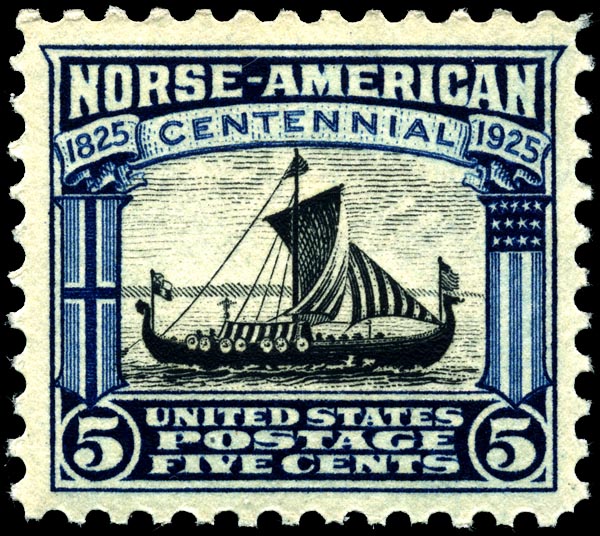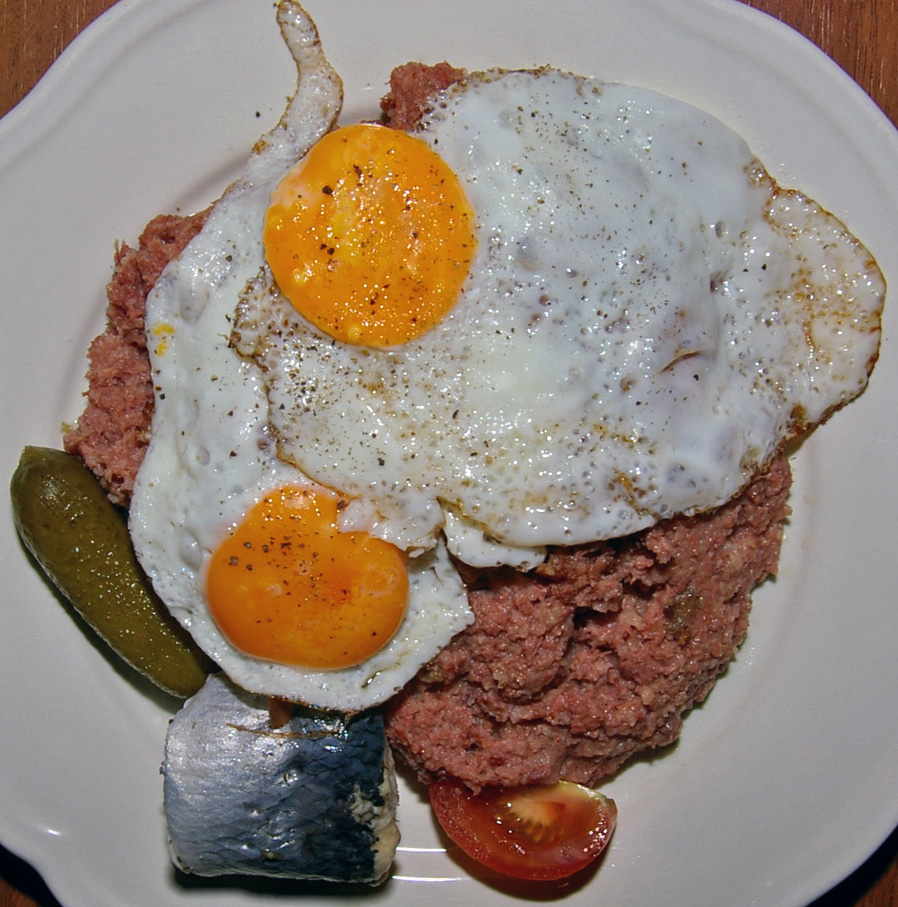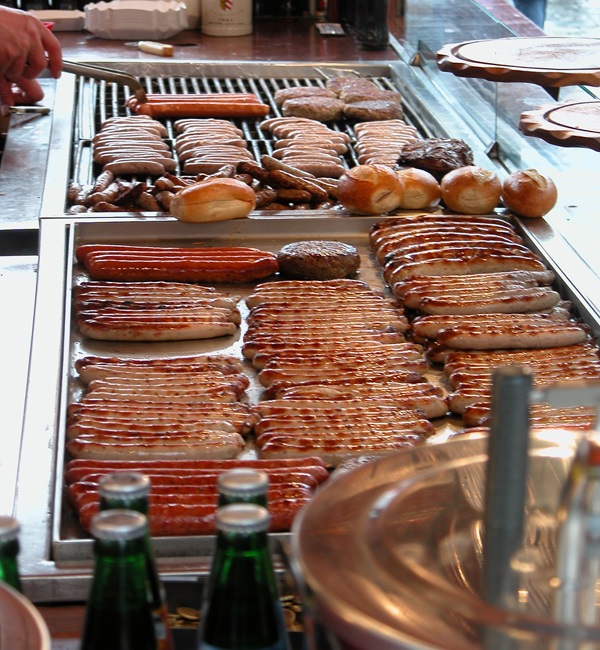|
Lapskaus
Lobscouse (or ''lapskaus'') is a thick Norwegian stew made of meat and potatoes. There are many variations of ''lapskaus''. The dish may be made of fresh or leftover meat (usually beef or lamb, but sometimes also chicken, pork, or ham) and potatoes. Other typical ingredients are vegetables (such as carrots, onions, leeks, celery root, and rutabaga) and spices (such as salt, pepper, ginger, and herbs). ''Lapskaus'' is possibly linked (historically and etymologically) to lobscouse, a European sailors' stew or hash strongly associated with major ports such as Liverpool. Similar dishes include the Danish , Finnish or the German . The dish also figures in Norwegian American cuisine. In 1970, lapskaus was part of "the official menu for the seamen's mess" of the Norwegian America Line. Until the 1980s, Brooklyn's Eighth Avenue (particularly between 50th and 60th streets) was known as "Lapskaus Boulevard Eighth Avenue is a major street in Brooklyn, New York City. It was form ... [...More Info...] [...Related Items...] OR: [Wikipedia] [Google] [Baidu] |
Lapskaus Boulevard
Eighth Avenue is a major street in Brooklyn, New York City. It was formerly an enclave for Norwegians and Norwegian-Americans, who have recently become a minority in the area among the current residents, which include new immigrant colonies, among them Chinese and Arabic-speaking peoples. Parts of it have been colloquially re-christened '' Little Hong Kong'' in recognition of these newer communities. The avenue starts at its north at Grand Army Plaza, going through Park Slope for . It is interrupted by the Green-Wood Cemetery between 20th and 39th Streets, and after traveling nearly further south through Sunset Park, finally ends at 73rd Street in Bay Ridge. Lapskaus Boulevard ''Lapskaus Boulevard'' is the nickname of part of Eighth Avenue, in a historically Norwegian working-class section of bordering Bay Ridge, and Sunset Park. In the earlier part of the 20th century, the part of Eighth Avenue in Sunset Park was primarily home to Norwegian immigrants, and it was known as "Li ... [...More Info...] [...Related Items...] OR: [Wikipedia] [Google] [Baidu] |
Eighth Avenue (Brooklyn)
Eighth Avenue is a major street in Brooklyn, New York City. It was formerly an enclave for Norwegians and Norwegian-Americans, who have recently become a minority in the area among the current residents, which include new immigrant colonies, among them Chinese and Arabic-speaking peoples. Parts of it have been colloquially re-christened '' Little Hong Kong'' in recognition of these newer communities. The avenue starts at its north at Grand Army Plaza, going through Park Slope for . It is interrupted by the Green-Wood Cemetery between 20th and 39th Streets, and after traveling nearly further south through Sunset Park, finally ends at 73rd Street in Bay Ridge. Lapskaus Boulevard ''Lapskaus Boulevard'' is the nickname of part of Eighth Avenue, in a historically Norwegian working-class section of bordering Bay Ridge, and Sunset Park. In the earlier part of the 20th century, the part of Eighth Avenue in Sunset Park was primarily home to Norwegian immigrants, and it was known as "Li ... [...More Info...] [...Related Items...] OR: [Wikipedia] [Google] [Baidu] |
Norwegian American
Norwegian Americans ( nb, Norskamerikanere, nn, Norskamerikanarar) are Americans with ancestral roots in Norway. Norwegian immigrants went to the United States primarily in the latter half of the 19th century and the first few decades of the 20th century. There are more than 4.5 million Norwegian Americans, according to the 2021 U.S. census,; most live in the Upper Midwest and on the West Coast of the United States. Immigration Viking-era exploration Norsemen from Greenland and Iceland were the first Europeans to reach North America. Leif Erikson reached North America via Norse settlements in Greenland around the year 1000. Norse settlers from Greenland founded the settlement of L'Anse aux Meadows and Point Rosee in Vinland, in what is now Newfoundland, Canada. These settlers failed to establish a permanent settlement because of conflicts with indigenous people and within the Norse community. Colonial settlement The Netherlands, and especially the cities of Amsterdam and ... [...More Info...] [...Related Items...] OR: [Wikipedia] [Google] [Baidu] |
Labskaus
Labskaus () is a culinary speciality from northern Germany and in particular from the cities of Bremen, Hamburg, and Lübeck. The main ingredients are salted meat or corned beef, potatoes, and onion. Some recipes put beetroot, pickled gherkin, or even herring into it, while others have these ingredients as side dishes.SPIEGEL Online on Labskaus in Hamburg (German) Der Spiegel Etymology The origin of this word is uncertain. One possible source for the name could be Latvian ''Labs kauss'', meaning 'good bowl' or hotpot, or Lith ...[...More Info...] [...Related Items...] OR: [Wikipedia] [Google] [Baidu] |
Norwegian Cuisine
Norwegian cuisine in its traditional form is based largely on the raw materials readily available in Norway and its mountains, wilderness, and coast. It differs in many respects from continental cuisine through the stronger focus on game and fish. Many of the traditional dishes are the result of using conserved materials, necessary because of the long winters. Modern Norwegian cuisine, although still strongly influenced by its traditional background, has been influenced by globalization: pasta, pizza, tacos, and the like are as common as meatballs and cod as staple foods. Typical main meals Most Norwegians eat three or four regular meals a day, usually consisting of a cold breakfast with coffee, a cold (usually packed) lunch at work and a hot dinner at home with the family. Depending on the timing of family dinner (and personal habit), some may add a cold meal in the late evening, typically a simple sandwich. Breakfast (''frokost'') The basic Norwegian breakfast consists of br ... [...More Info...] [...Related Items...] OR: [Wikipedia] [Google] [Baidu] |
Ginger
Ginger (''Zingiber officinale'') is a flowering plant whose rhizome, ginger root or ginger, is widely used as a spice A spice is a seed, fruit, root, bark, or other plant substance primarily used for flavoring or coloring food. Spices are distinguished from herbs, which are the leaves, flowers, or stems of plants used for flavoring or as a garnish. Spice ... and a folk medicine. It is a herbaceous perennial plant, perennial which grows annual pseudostems (false stems made of the rolled bases of leaves) about one meter tall bearing narrow leaf blades. The inflorescences bear flowers having pale yellow petals with purple edges, and arise directly from the rhizome on separate shoots. Ginger is in the family (taxonomy), family Zingiberaceae, which also includes turmeric (''Curcuma longa''), cardamom (''Elettaria cardamomum''), and galangal. Ginger originated in Maritime Southeast Asia and was likely domesticated first by the Austronesian peoples. It was transported with ... [...More Info...] [...Related Items...] OR: [Wikipedia] [Google] [Baidu] |
New York University Press
New York University Press (or NYU Press) is a university press that is part of New York University. History NYU Press was founded in 1916 by the then chancellor of NYU, Elmer Ellsworth Brown. Directors * Arthur Huntington Nason, 1916–1932 * No director, 1932–1946 * Jean B. Barr (interim director), 1946–1952 * Filmore Hyde, 1952–1957 * Wilbur McKee, acting director, 1957–1958 * William B. Harvey, 1958–1966 * Christopher Kentera, 1966–1974 * Malcolm C. Johnson, 1974–1981 * Colin Jones, 1981–1996 * Niko Pfund, 1996–2000 * Steve Maikowski, 2001–2014 * Ellen Chodosh, 2014–present Notable publications Once best known for publishing '' The Collected Writings of Walt Whitman'', NYU Press has now published numerous award-winning scholarly works, such as ''Convergence Culture'' (2007) by Henry Jenkins, ''The Rabbi's Wife'' (2006) by Shuly Schwartz, and ''The Encyclopedia of Jewish Life Before and During the Holocaust'' (2002). Other well-known names publish ... [...More Info...] [...Related Items...] OR: [Wikipedia] [Google] [Baidu] |
Brooklyn
Brooklyn () is a borough of New York City, coextensive with Kings County, in the U.S. state of New York. Kings County is the most populous county in the State of New York, and the second-most densely populated county in the United States, behind New York County (Manhattan). Brooklyn is also New York City's most populous borough,2010 Gazetteer for New York State . Retrieved September 18, 2016. with 2,736,074 residents in 2020. Named after the Dutch village of Breukelen, Brooklyn is located on the w ... [...More Info...] [...Related Items...] OR: [Wikipedia] [Google] [Baidu] |
Norwegian America Line
The Norwegian America Line ( no, Den Norske Amerikalinje), was a shipping line, originally an operator of ocean liners and cargo ships. Founded in 1910, the company ran a regular transatlantic service between Norway and the United States, and later included a route to East Africa as well. Primarily due to competition from air travel, transatlantic passenger voyages were slowly discontinued during the years. After the Great War, the company was one of Norway’s largest shipping lines, owning a fleet that included 19 vessels, several of which were for commercial cargo transport. After the Second World War heavy ships losses were overcome by the building of new vessels, however the reduction in the passengers’ traffic by sea shifted the company’s focus mainly to the cargo business, including container and bulk shipping from the 1970s. In 1980 the last two passenger liners were handed over into a new joint venture company (Norwegian American Cruises) with Leif Höegh & Co, and f ... [...More Info...] [...Related Items...] OR: [Wikipedia] [Google] [Baidu] |
German Cuisine
The cuisine of Germany () is made up of many different local or regional cuisines, reflecting the country's federal history. Germany itself is part of the larger cultural region of Central Europe, sharing many culinary traditions with neighbouring countries such as Poland and the Czech Republic. Southern regions, like Bavaria and Swabia, share dishes with Austrian cuisine and parts of Swiss cuisine. The Michelin Guide of 2015 awarded a three-star ranking (the highest designation) to 11 restaurants in Germany, while 38 more received two-star rankings and 233 one-star rankings. , Germany had the fourth-highest number of Michelin three-star restaurants in the world, after Japan, France, and the United States. Hot foods Meat The average annual meat consumption is per person. The most common varieties are pork, poultry and beef. Other varieties of meat are widely available, but are considered to be insignificant. Source: Statista.com, 2017 Meat is usually braised; fried dish ... [...More Info...] [...Related Items...] OR: [Wikipedia] [Google] [Baidu] |
Finnish Cuisine
Finnish cuisine is notable for generally combining traditional country fare and ''haute cuisine'' with contemporary continental style cooking. Fish and meat (usually pork, beef or reindeer) play a prominent role in traditional Finnish dishes in some parts of the country, while the dishes elsewhere have traditionally included various vegetables and mushrooms. Evacuees from Karelia contributed to foods in other parts of Finland in the aftermath of the Continuation War. Finnish foods often use wholemeal products ( rye, barley, oats) and berries (such as bilberries, lingonberries, cloudberries, and sea buckthorn). Milk and its derivatives like buttermilk are commonly used as food, drink or in various recipes. Various turnips were common in traditional cooking, but were replaced with the potato after its introduction in the 18th century. Characteristics The way of life and culture of Finns was mainly based on agriculture already at prehistoric times. However, in the harsh and col ... [...More Info...] [...Related Items...] OR: [Wikipedia] [Google] [Baidu] |
Danish Cuisine
Danish cuisine ( da, det danske køkken) originated from the peasant population's own local produce and was enhanced by cooking techniques developed in the late 19th century and the wider availability of goods during and after the Industrial Revolution. Open sandwiches, known as '' smørrebrød'', which in their basic form are the usual fare for lunch, can be considered a national speciality when prepared and decorated with a variety of fine ingredients. Hot meals are typically prepared with meat or fish. Substantial meat and fish dishes includes ''flæskesteg'' (roast pork with crackling) and ''kogt torsk'' (poached cod) with mustard sauce and trimmings. Ground meats (pork, veal or beef) became widespread during the industrial revolution and traditional dishes that are still popular include ''frikadeller'' (meat balls), ''karbonader'' (breaded pork patties) and ''medisterpølse'' (fried sausage). Denmark is known for its Carlsberg and Tuborg beers and for its akvavit and bitters ... [...More Info...] [...Related Items...] OR: [Wikipedia] [Google] [Baidu] |




.jpg)

